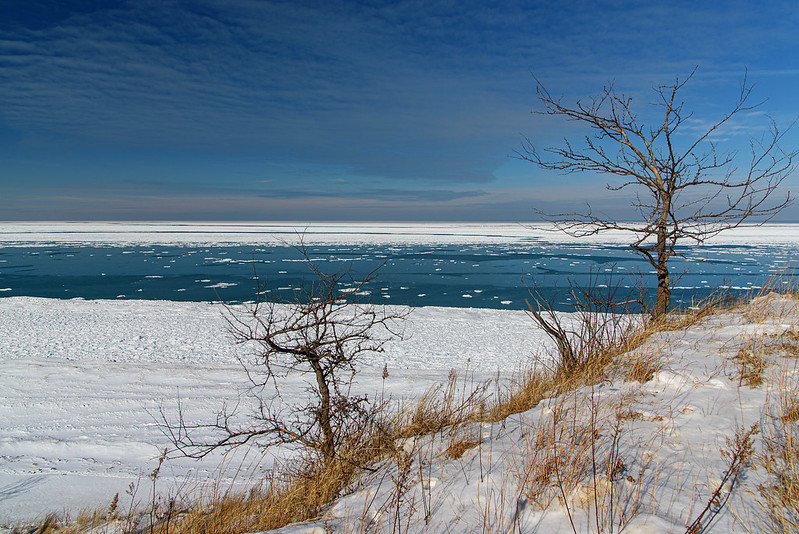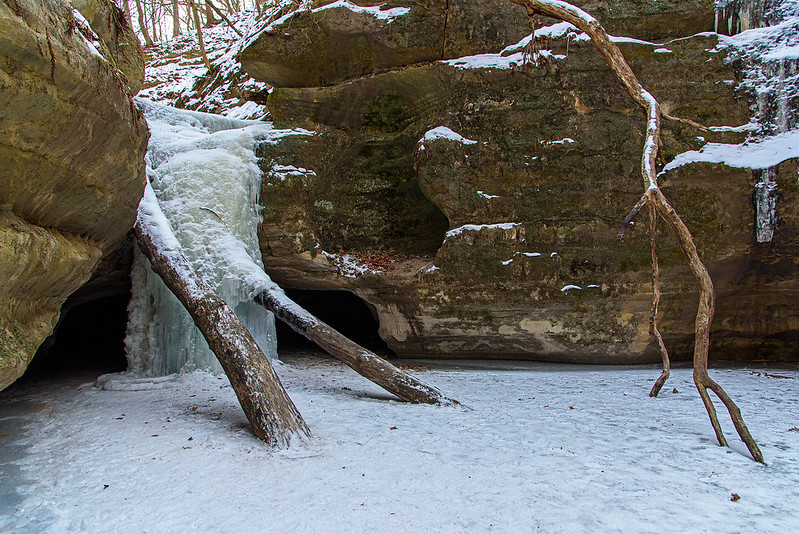
The Icy Punch Bowl

Gypsy Gulch in Winter

The Living Dune: Mt. Baldy

Marshmallow Snow

Ice Volcanoes Of Lake Michigan

If it's windy when the weather turns cold, the shelf ice mounds up along the shore - often forming these conical formations. If it's relatively calm when the ice forms, the shelf ice is rather flat. If we look at the photos from this year, the beginning of the freeze up was relatively calm because the ice near the shore is flat; then some windy days occurred creating some 15 foot tall mounds a bit further away from shore.
The Growing Ice on Lake Michigan

Deep in French Canyon

KasKaskia's Frozen Waterfall
 One of the smaller waterfalls and canyons of Starved Rock State Park is Kaskaskia. Located on a trail outside of the commonly visited area, it's grouped with two other interesting features of the park - Ottawa Canyon, and the Council Overhang.
One of the smaller waterfalls and canyons of Starved Rock State Park is Kaskaskia. Located on a trail outside of the commonly visited area, it's grouped with two other interesting features of the park - Ottawa Canyon, and the Council Overhang. The Ice Curtain

The Frozen Waterfall of Ottawa Canyon
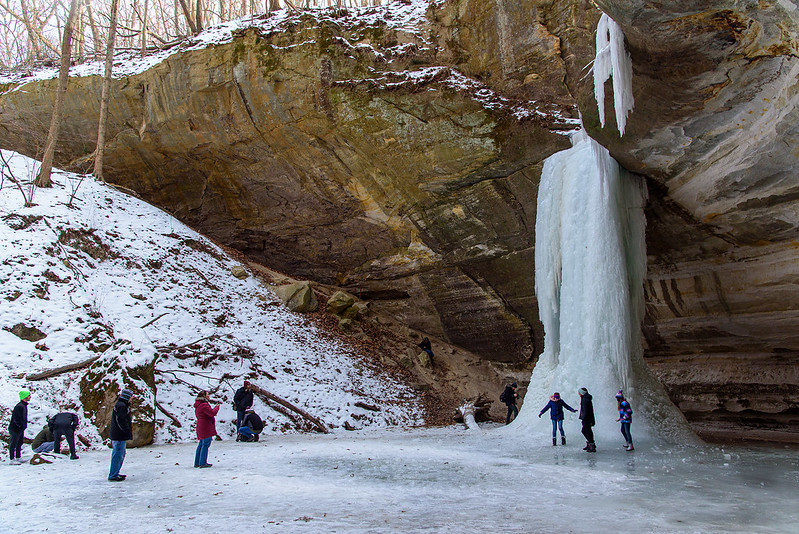
Located in a blind canyon, the waterfall of Ottawa Canyon dramatically reveals itself as you walk down the canyon. This year was probably the most crowded I've ever experienced the canyons in winter. It was certainly a nice day for winter - temperatures in the 20's and sun - and it was a weekend. I generally visit these canyons on weekdays to avoid so many people, but it's really nice to see families visiting natural sites instead of looking at them on the internet.
The Cold beach

The Dune Point
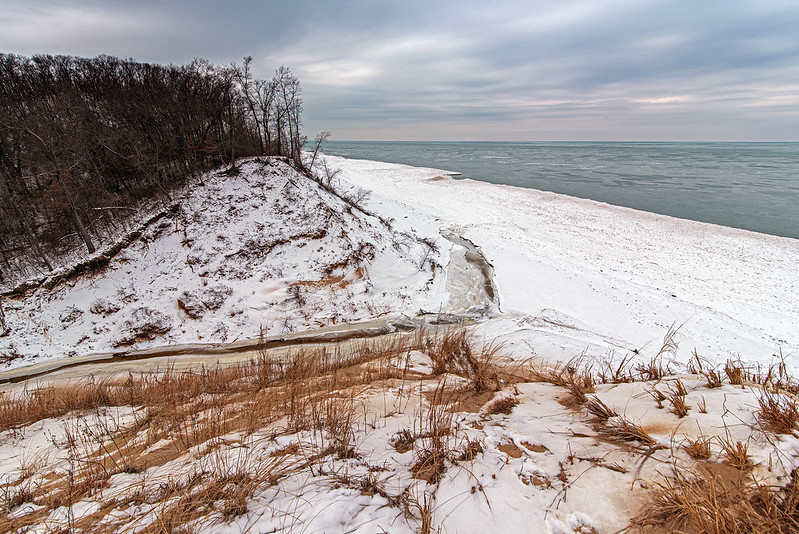
I suspect in a few more days the ice will form almost as far as the eye can see; it's so interesting to visit in the winter to see these changes. The lake looks more like the Arctic Ocean when it freezes up.
Contemplating

On the Tallest Dune

Central Beach in Early Winter

Ice Formations Along the Shore
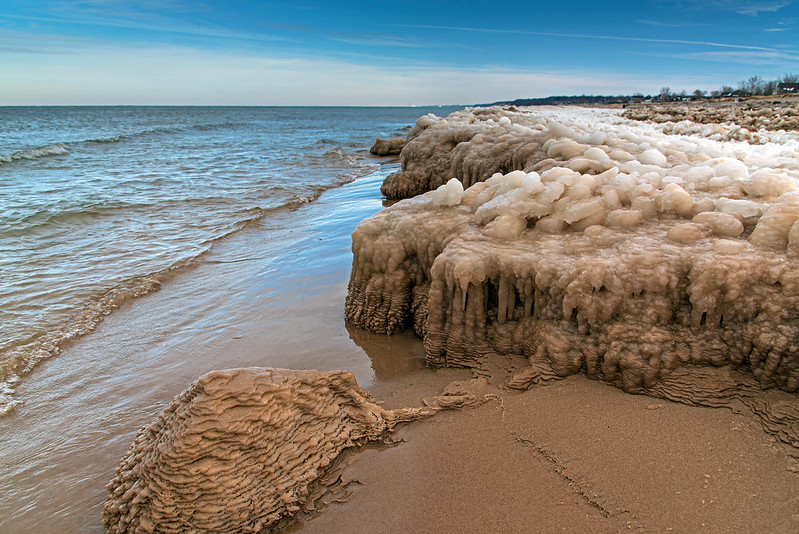 The cold weather begins to build up some shelf ice along the shore of Lake Michigan. At this early stage, the ice has not yet formed a shelf, and is completely attached to the land, so it's still safe to explore. In a few days, it will begin to form over the water, and that will be dangerous to venture onto.
When the waves begin to mound up the floe ice and ice chunks floating in the lake, the shelf ice will begin to pile up into mounds reaching 15 or 20 feet high. Before that, the ice now forms intricate shapes as the water flows back and forth on the beach. The formations created look a lot like stalactites and stalagmites in caves. I suppose both features are created in a similar manner, only the ice is fast and seasonal, while the limestone formations take thousands of years to form.
The cold weather begins to build up some shelf ice along the shore of Lake Michigan. At this early stage, the ice has not yet formed a shelf, and is completely attached to the land, so it's still safe to explore. In a few days, it will begin to form over the water, and that will be dangerous to venture onto.
When the waves begin to mound up the floe ice and ice chunks floating in the lake, the shelf ice will begin to pile up into mounds reaching 15 or 20 feet high. Before that, the ice now forms intricate shapes as the water flows back and forth on the beach. The formations created look a lot like stalactites and stalagmites in caves. I suppose both features are created in a similar manner, only the ice is fast and seasonal, while the limestone formations take thousands of years to form.
 In this small formation, almost every layer can be seen from the ground up, almost like a topographical map. These same layers can be seen all around the shore at this time, but will eventually be covered in large chunks of ice and snow. Only time will tell if the shelf ice builds hundreds of feet out into the lake, or if it will remain as is for the rest of the winter.
In this small formation, almost every layer can be seen from the ground up, almost like a topographical map. These same layers can be seen all around the shore at this time, but will eventually be covered in large chunks of ice and snow. Only time will tell if the shelf ice builds hundreds of feet out into the lake, or if it will remain as is for the rest of the winter.
Haunting Ice
 What was a bright, sunny day as we arrived at the St. Joseph, Michigan lighthouse, turned to an overcast winter day quite quickly, and dramatically. In fact, the fleeting transition between sun and clouds lasted only a moment or two.
An overcast day generally provides very flat light, no real bright spots, no dramatic shadows. Compare that to a sunny day where the dynamic range in light is extreme from sun to shadow. When the clouds rolled in, they blocked most of the sun quickly, but the last few rays of sun illuminated the ice against the dark clouds and water. This created a dramatic, haunting look and feel to this image.
What was a bright, sunny day as we arrived at the St. Joseph, Michigan lighthouse, turned to an overcast winter day quite quickly, and dramatically. In fact, the fleeting transition between sun and clouds lasted only a moment or two.
An overcast day generally provides very flat light, no real bright spots, no dramatic shadows. Compare that to a sunny day where the dynamic range in light is extreme from sun to shadow. When the clouds rolled in, they blocked most of the sun quickly, but the last few rays of sun illuminated the ice against the dark clouds and water. This created a dramatic, haunting look and feel to this image.
Ice Around the Pier
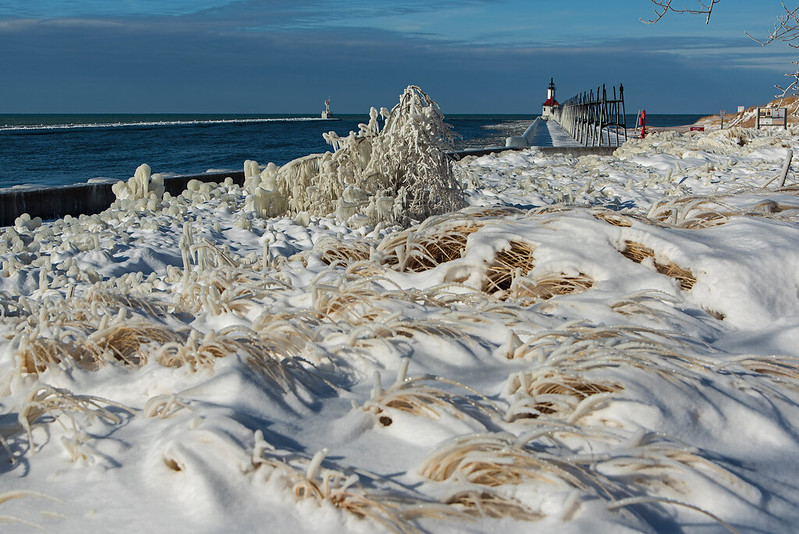
The "Hoodoos" of St. Joseph Michigan

The Ice is Beginning to Form

The new year brought some frigid weather to the southern Lake Michigan area, enough to begin the creation of some thick ice on the pier and catwalk of the St. Joseph, Michigan lighthouse. Typically, the ice begins to form much earlier in the season - sometimes in late November - but this winter, conditions weren't right until now.
Conditions include very cold temperatures, winds high enough to churn up waves that crash into the pier and lighthouse, and a liquid lake (not frozen yet) so waves can build up. A layer of ice on the lake prevents the water from splashing up, so later in the winter when the lake usually freezes over, ice rarely builds on the lighthouses.

While the ice hasn't yet covered the lighthouse, it is beginning to freeze the surfaces of the pier, railings, and catwalk. The ice on the railings is already about two feet thick may continue to build depending on how conditions are in the future.
Many years ago, winters along the Lake Michigan shoreline were generally lonely, very few people ventured to view the lighthouses or ice along the shore. In recent years, however, crowds of people brave the cold weather to experience the ice formations. As long as the everyone keeps off the ice, it's a great thing to see.












